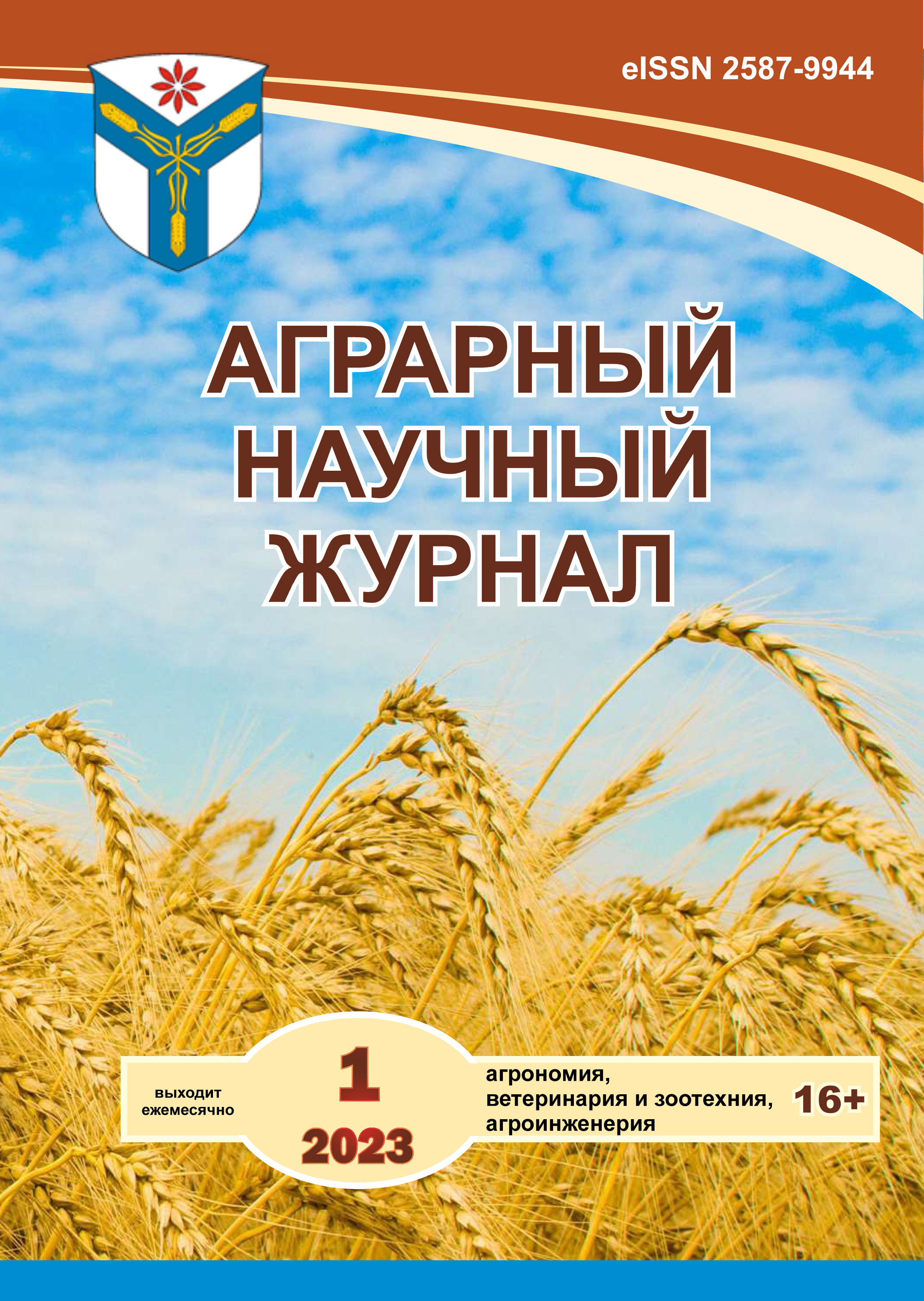Productivity of the clover and timothy mixture when using microbiological preparations
DOI:
https://doi.org/10.28983/asj.y2023i1pp41-47Keywords:
biological products, clover-timothy mixture, yield of green mass, dry matter content, nutritional valueAbstract
The article presents the results of studying the effect of biological preparations created on the basis of such living microbial strains as Bacillus subtilis (Naturost), Lactobacillus buchneri (Naturost-Active) and Bacillus megaterium (Naturost-M) on productivity and nutritional value of the clover and timothy mixture. We conducted a microplot experiment at the Vologda Research Center of the Russian Academy of Sciences (Vologda Oblast) in 2019–2021. With the use of biopreparations, the fresh and dry matter yield of the clover and timothy mixture increased by 16.8–32.6% and 20.8–29.8% respectively, depending on the biopreparation used, the volume of cut and the year of study. The nutritive value of the clover and timothy mixture varied significantly over the years of the study, however, in general, the effect of the biopreparations contributed to a certain increase in the content of fodder units and metabolizable energy of the herbage mixture. In the 2019 study, the increase in the nutritional value of herbage was more due to the use of a preparation based on the bacteria Bacillus megaterium. In 2020, a more pronounced increase in the content of fodder units, metabolizable energy, crude protein, digestible protein and fat content occurred when using a preparation based on Bacillus subtilis bacteria, while in 2021 it was based on Bacillus megaterium and Lactobacillus buchneri.
Downloads
References
Байкалова Л. П., Кривоногова Д. В., Едимеичев Ю. Ф. Ресурсосберегающие технологии производства кормов из многолетних трав в Красноярском крае // Вестник ИрГСХА. 2017. № 79. С. 18–23.
Бельченко А. С., Дронов А. В., Ториков В. Е., Белоус И. Н. Актуальные задачи по развитию продовольственной сферы АПК Брянской области // Кормопроизводство. 2016. № 9. С. 3–7.
Богатырева Е. В., Корельская Л. А., Фоменко П. А., Щекутьева Н. А. Продуктивность люцерны изменчивой в одновидовых и смешанных посевах и сравнительная оценка силоса из люцерны в чистом виде и в смеси с бобовыми и злаковыми травами в условиях Вологодской области // Молочнохозяйственный вестник. 2019. № 4(36). С. 8–20.
Ганущенко О. Ф. Переваримость и питательность объемистых кормов из клевера и клеверо-злаковых смесей // Ученые записки УО ВГАВМ. 2005. № 1. С. 121–122.
Замана С. П., Соколов А. В., Кондратьева Т. Д. О применении бактериального препарата в опыте с клеверотимофеечной травосмесью // Кормопроизводство. 2013. № 9. С. 16–17.
Злотников А. К., Злотников К. М., Харченко Г. Л., Рябчинская Т.А. Влияние Альбита на развитие и продуктивность кормовых трав // Земледелие. 2009. № 6. С. 32–33.
Каракчиева Е.Ф. Перспективные бобово-злаковые травосмеси для полевого кормопроизводства на Севере // Кормопроизводство. 2015. № 9. С. 3–6.
Маркова И. А., Гузюк М. Е., Вервейко И. В. Основы сельскохозяйственных пользований. СПб., 2001. 126 с.
Сидорова Т. М., Асатурова А. М., Хомяк А. И. Биологически активные метаболиты Bacillus subtilis и их роль в контроле фитопатогенных микроорганизмов // Сельскохозяйственная биология. 2018. Т. 53. №. 1. С. 29–37. Режим доступа: https://doi.org/10.15389/agrobiology.2018.1.29rus.
Соболева Н. В., Карамаев С. В., Карамаева А. С. Качество сыра в зависимости от вида кормовых культур, используемых при приготовлении сенажа // Известия Оренбургского государственного аграрного университета. 2015. № 6 (56). С. 145–147.
Статистика // Федеральная служба государственной статистики. 1999–2022. Режим доступа: https://rosstat.gov.ru/statistic (дата обращения: 30.03.2022).
Analysis of the potential associated with the siderophores synthesis in the Bacillus subtilis strain using whole genome sequencing / T. Dunyashev et al. // Lecture Notes in Networks and Systems. 2022. 354 LNNS. P. 663–669. URL: https://doi.org/10.1007/978-3-030-91405-9_73.
Gummalla S., Broadbent J. R. Tryptophan catabolism by Lactobacillus casei and Lactobacillus helveticus cheese flavor adjuncts // Journal of Dairy Science. 1999. No. 82 (10). P. 2070–2077. URL: https://doi.org/10.3168/jds.S0022-0302(99)75448-2.
Characterization of polyvalent and safe Bacillus thuringiensis strains with potential use for biocontrol / N. Raddadi et al. // Journal of basic microbiology. 2009. No. 49 (3). P. 293–303. URL: https://doi.org/10.1002/jobm.200800182.
Radhakrishnan R., Hashem A., Abd-Allah E. F. Bacillus: a biological tool for crop improvement through bio-molecular changes in adverse environments // Frontiers in physiology. 2017. No. 8. P. 667. URL: https://doi.org/10.3389/fphys.2017.00667.
Bacterial endophytes enhance competition by invasive plant / M. E. Rout et al. // American Journal of Botany. 2013. No. 100 (9). P. 1726–1737. URL: https://doi.org/10.3732/ajb.1200577.
Bacillus spp. inoculation improves photosystem II efficiency and enhances photosynthesis in pepper plants / B.Ye. Samaniego-G?mez et al. // Chilean J. Agric. Res. 2016. No. 76.(4). P. 409–416. URL: https://doi.org/10.4067/S0718-58392016000400003.
Downloads
Published
Issue
Section
License
Copyright (c) 2023 The Agrarian Scientific Journal

This work is licensed under a Creative Commons Attribution-NonCommercial-NoDerivatives 4.0 International License.








